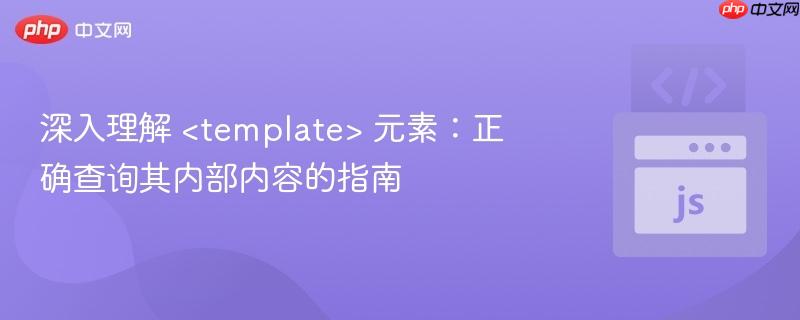 元素:正确查询其内部内容的指南
" />
元素:正确查询其内部内容的指南
" />
html 元素提供了一种在页面加载时不会被渲染的机制,它用于保存客户端内容,这些内容在稍后可以通过 javascript 进行实例化和插入到文档中。 内部的任何内容在页面加载时都不会被浏览器渲染,也不会被视为文档流的一部分。这使得它成为存储可重用ui组件或复杂结构片段的理想选择。
然而,由于其独特的“非激活”状态,直接使用 document.getElementsByTagName() 或 element.querySelector() 等方法在 元素本身上查询其内部元素时,往往会发现无法获取到任何结果。这是因为 元素的内容被封装在一个特殊的文档片段(DocumentFragment)中,而不是直接作为 元素的子节点暴露在常规的DOM查询接口下。
考虑以下HTML结构,其中包含一个带有 标签的 元素:
<template></template> <template> <link/> </template> <template></template>
如果尝试直接在 元素上查询内部的 标签,如下所示:
const templates = [...document.getElementsByTagName('template') || []];
console.log(`Found ${templates.length} template(s)`);
templates.map((template) => {
// 错误示范:直接在 template 元素上查询
const links = [...template.getElementsByTagName('link') || []];
console.log(`Found ${links.length} link(s)`);
});上述代码的输出将显示找到3个 template 元素,但每个 template 内部的 link 元素数量都为0,即使第二个 template 确实包含一个 标签。这是因为 template.getElementsByTagName('link') 在这种情况下无法访问到 DocumentFragment 中的内容。
要正确地访问和查询 元素内部的内容,必须通过其 content 属性。template.content 返回一个 DocumentFragment 对象,它包含了 元素的所有子节点。一旦获取到这个 DocumentFragment,就可以在其上使用标准的DOM查询方法,如 querySelector()、querySelectorAll() 或 getElementsByTagName()。
以下是修正后的 JavaScript 代码示例:
// 示例 HTML 结构
/*
<template></template>
<template>
<link/>
</template>
<template></template>
*/
// 1. 获取所有 元素
const templates = [...document.querySelectorAll('template')];
console.log(`Found ${templates.length} template(s)`); // 预期输出: Found 3 template(s)
// 2. 遍历每个 元素
templates.map((template) => {
// 关键:通过 template.content 访问其内部的 DocumentFragment
// 然后在 DocumentFragment 上执行查询操作
const links = [...template.content.querySelectorAll('link')];
console.log(`Found ${links.length} link(s)`);
});运行上述修正后的代码,您将看到正确的输出:
Found 3 template(s) Found 0 link(s) Found 1 link(s) Found 0 link(s)
这明确表明,通过 template.content 属性,我们成功地访问并查询到了 元素内部的 标签。
DocumentFragment 是一种轻量级的文档对象,它能够像一个标准的文档一样存储节点,但它不是实际DOM树的一部分。当 DocumentFragment 被插入到文档中时,它的子节点会被添加到文档中,而不是 DocumentFragment 本身。这使得 DocumentFragment 在构建DOM结构时非常有用,因为它可以在内存中操作节点而不会引起页面的回流和重绘,从而提高性能。
在 元素的上下文中,template.content 返回的 DocumentFragment 封装了 标签内定义的所有HTML元素。这些元素处于“休眠”状态,直到 DocumentFragment 被克隆(通常通过 cloneNode(true))并插入到实际的DOM中。
const templateContent = document.getElementById('myTemplate').content;
const clonedContent = templateContent.cloneNode(true); // 深度克隆所有子节点
document.body.appendChild(clonedContent);直接插入 template.content 会将其内容从 中“移动”出去,而不是复制。
元素是HTML中一个强大且有用的特性,用于定义可延迟渲染的HTML内容。然而,要正确地与 内部的元素进行交互,必须理解其内容被封装在 template.content 属性返回的 DocumentFragment 中。通过在 template.content 上执行标准的DOM查询方法,开发者可以有效地访问、操作和利用 中定义的结构,从而实现更高效和模块化的Web开发。
以上就是深入理解 元素:正确查询其内部内容的指南的详细内容,更多请关注php中文网其它相关文章!

每个人都需要一台速度更快、更稳定的 PC。随着时间的推移,垃圾文件、旧注册表数据和不必要的后台进程会占用资源并降低性能。幸运的是,许多工具可以让 Windows 保持平稳运行。

Copyright 2014-2025 https://www.php.cn/ All Rights Reserved | php.cn | 湘ICP备2023035733号